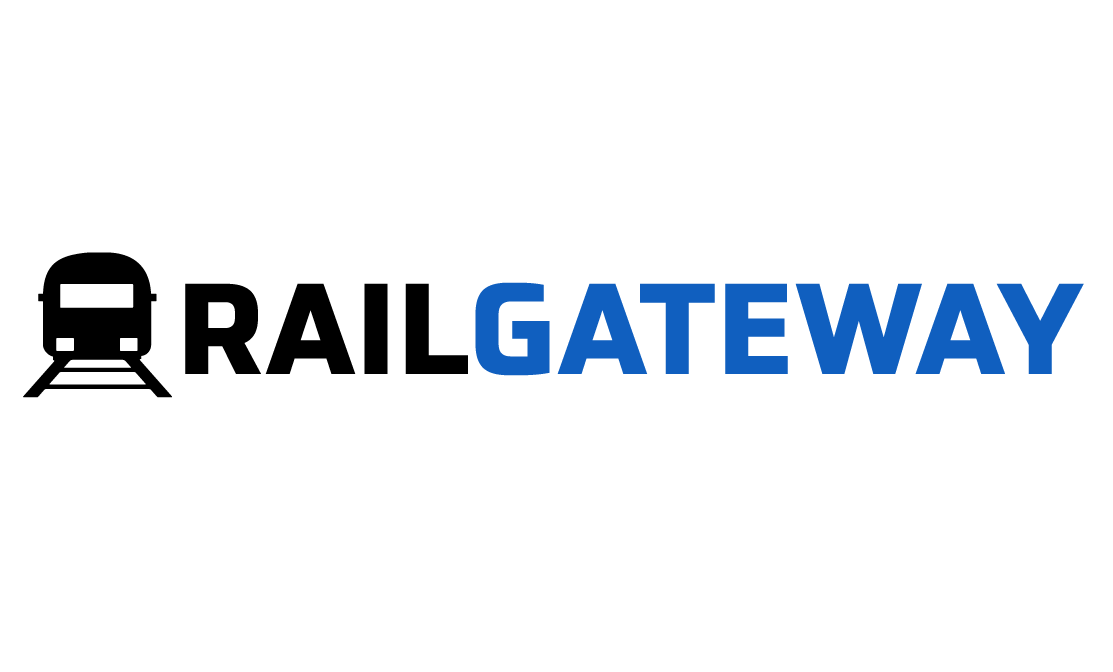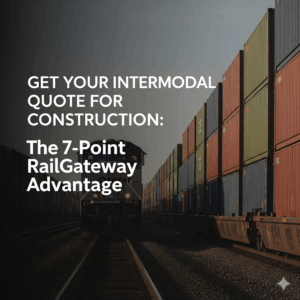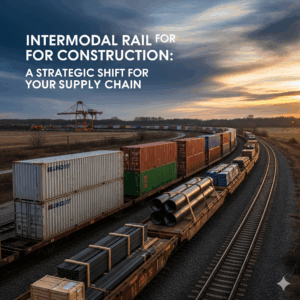From Strategic Decision to Confident Action
You have reached the final and most crucial stage in optimizing your automotive supply chain. Your journey has taken you from exploring the high-level benefits of intermodal shipping to a detailed analysis of how it stacks up against traditional trucking for your specific needs. The research is done. The business case is clear. You have made the strategic decision to pursue a logistics model that is more cost-effective, predictable, and sustainable.
The question is no longer “Why?” but “How?” How do you translate this strategic decision into a smooth and successful real-world implementation?
This guide is your definitive implementation playbook. This is not a theoretical article; it is a practical, step-by-step roadmap designed to demystify the entire process, from preparing the initial data for a quote to watching your first container arrive precisely on schedule at its destination. We will walk you through seven clear, actionable steps that will remove any perceived complexity and empower you to launch your intermodal strategy with absolute confidence. By the end of this guide, you will be fully prepared to engage a logistics partner and execute a flawless first shipment.
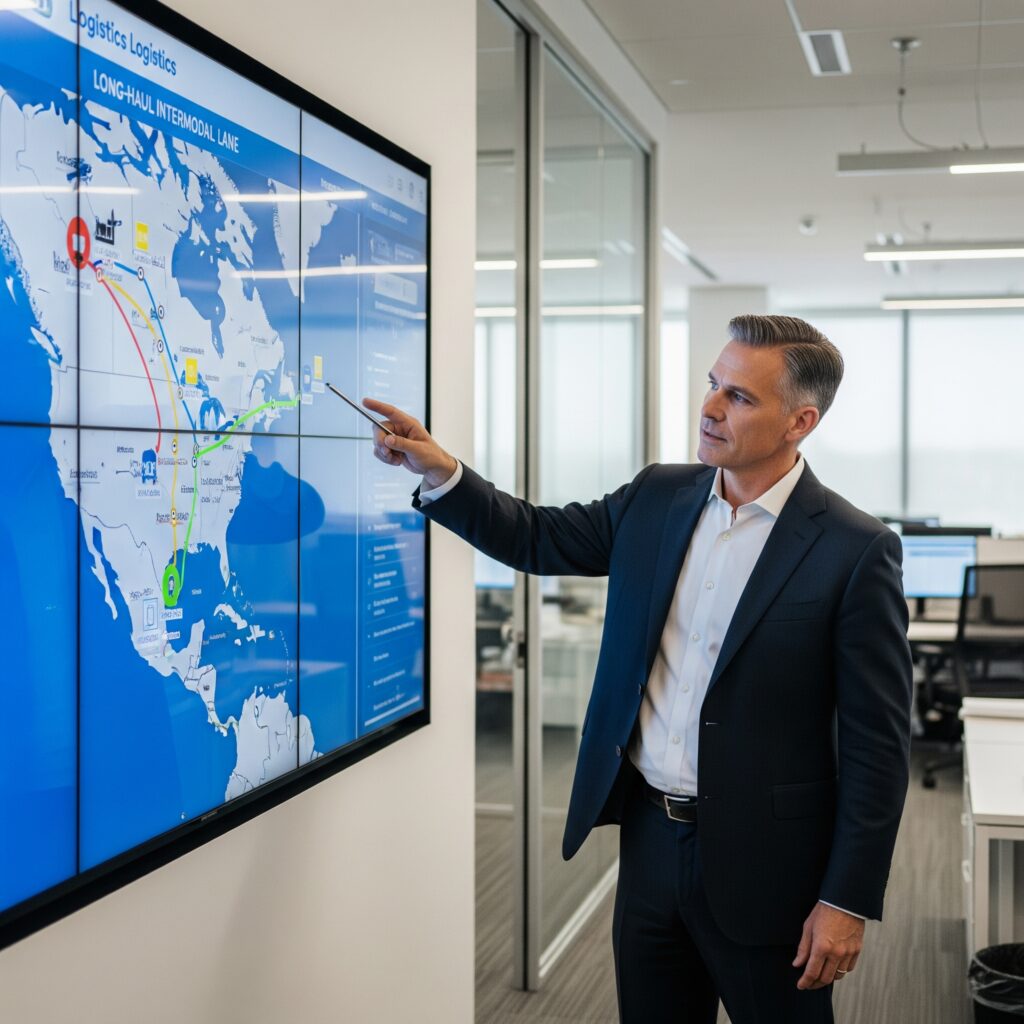
The 7-Step Implementation Guide
Part 1: The Pre-Launch Strategy
Success in logistics is determined long before a container is loaded. The first two steps are about laying a solid foundation through meticulous data preparation and careful partner selection.
Step 1: Preparing Your Data for an Ironclad Quote
This is the most critical step in the entire process, as the quality of your quote is directly proportional to the quality of the data you provide. A vague request will yield a vague estimate, but precise details will result in a firm, reliable quote you can take to your finance department. Before contacting a potential partner, assemble the following information:
- 1.1. Precise Lane Details: Go beyond “Mexico to Canada.” You need the exact postal or zip codes for the physical pickup location (your facility or your supplier’s) and the final delivery destination (the assembly plant or distribution center). This is essential for accurately calculating the first- and last-mile trucking (drayage) costs, which are a key component of the total price.
- 1.2. Specific Component/Part Details: “Automotive parts” is not enough detail. Be prepared to describe the specific commodity. Is it palletized engine components? Racked body panels? Boxed wiring harnesses? This information impacts handling, weight distribution, and freight classification. Providing an accurate description ensures there are no surprises and that the appropriate equipment is used.
- 1.3. Dunnage and Packaging Information: How are your parts packaged for transit? Are they in standardized returnable containers? Are they in custom-built racks? Do they require special dunnage (like foam inserts or custom bracing) to prevent damage? This information is vital for weight calculations and ensuring the load can be properly secured inside the container to withstand the forces of a rail journey.
- 1.4. Volume and Frequency Projections: Your logistics partner needs to understand the scale of your operation. Are you looking for a one-time “spot quote” for a trial shipment? Or are you planning to establish a regular lane with a weekly volume of 5, 10, or 50 containers? Be as clear as possible about your projected volume. Consistent, high-volume freight allows a logistics partner to negotiate better long-term “contract rates” with the railroads, which can provide significant savings compared to the transactional spot market.
- 1.5. Special Requirements: The automotive supply chain often involves complex needs. Be sure to declare any special requirements upfront. This could include a need for temperature-controlled reefer containers (e.g., for certain adhesives or EV battery components), any materials classified as Hazmat, or a need for additional cargo insurance for exceptionally high-value components.
Step 2: Selecting an Automotive-Focused Logistics Partner
Your choice of logistics partner is the single most important decision you will make in this process. They are not just a vendor; they are an extension of your supply chain team. When evaluating partners, ask pointed questions to determine if they have the specific expertise required for the demanding world of automotive logistics.
- 2.1. Do They Truly Understand Just-in-Time (JIT)? Every logistics provider will claim to understand JIT. You need to verify it. Ask for their on-time performance metrics for lanes similar to yours. Ask them to describe their standard operating procedure for monitoring a JIT shipment and their communication protocol if a potential delay is detected. An experienced automotive partner will be able to speak fluently about managing tight delivery windows and the critical importance of predictability.
- 2.2. Do They Have Deep Cross-Border USMCA Expertise? The North American automotive supply chain is fundamentally a cross-border system. Your partner must be an expert in this area. They should be able to clearly explain how they manage customs brokerage, how they leverage in-bond shipments to bypass border congestion, and how they ensure all documentation is compliant with USMCA regulations. This expertise is non-negotiable for any shipper moving parts between Canada, the U.S., and Mexico.
- 2.3. What is Their Drayage Network Like Near Key Automotive Hubs? The quality of the first- and last-mile trucking is crucial. A great partner will have a deep network of reliable, vetted drayage carriers specifically in the key automotive regions you operate in—be it Ontario, Michigan, Ohio, the U.S. South, or the Bajío region of Mexico. This ensures they have access to the chassis and drivers needed to service your plants and suppliers efficiently, especially during periods of high demand.
- 2.4. Do They Offer Modern Technology for Real-Time Visibility? In an industry driven by data, you cannot afford to have your high-value parts in a logistical “black hole.” A qualified partner must offer a modern, user-friendly technology portal that provides, at a minimum:
- Easy quote requests and online booking.
- Real-time, end-to-end tracking of your shipment from pickup to delivery.
- A centralized location for all your shipping documents, including Bills of Lading and Proofs of Delivery.
This technology provides the visibility and control necessary to manage a high-performance automotive supply chain.
Part 2: The Execution Phase
With a solid data foundation and the right expert partner selected, you are ready to move from planning to execution. These next steps cover the commercial and physical process of turning your strategic decision into a container moving across the country.
Step 3: Decoding Your Quote & Locking In Your Rate
The quote you receive from a qualified, automotive-focused partner will be detailed and transparent. Understanding its structure is key to appreciating the value and making an informed commitment. Beyond the standard components of line-haul, fuel, and drayage, you should pay close attention to:
- Automotive-Specific Accessorials: The quote should clearly outline any potential fees for services beyond standard transport that are common in the automotive supply chain. This might include charges for chassis detention (if a driver has to wait an exceptionally long time at a busy assembly plant), fees for handling specialized equipment like racks or containers with custom fittings, or charges for pre-tripping and fueling a reefer unit for temperature-sensitive components. A transparent partner lists these upfront so you can work to avoid them.
- Spot Quote vs. Contract Rate: This is a crucial strategic distinction. A “spot quote” is a transactional, market-based price for a single shipment or a small number of shipments. It’s perfect for a trial run on a new lane. A “contract rate” is a negotiated price based on your commitment to provide a consistent, weekly volume on a specific lane for an extended period (typically 6-12 months). For the core, high-volume lanes that feed your production lines, your goal should always be to establish contract rates. This locks in your transportation cost, protects you from market volatility, and guarantees capacity, bringing the budget stability and predictability that are paramount in automotive logistics.
Step 4: The Seamless Booking and Onboarding Process
This is where your chosen logistics partner demonstrates their value by making a complex process feel simple. Once you have formally accepted a quote for a new lane, a professional onboarding process will begin.
- Account Setup: Your partner will create a detailed profile for your company in their Transportation Management System (TMS). This profile includes all your key locations, facility operating hours, contact personnel, and any specific operational requirements you have. This ensures that every future booking is handled consistently and correctly.
- The Single Point of Contact: You will work with your dedicated account representative, your single point of contact. Their job is to manage all the complex backend processes on your behalf.
- Tendering a Load: To book a shipment, you simply “tender” the load information to your representative. This typically includes the Purchase Order (PO) number, the requested pickup date, and the final delivery requirements.
- Behind the Scenes: Your partner then executes the crucial backend work. They dispatch a vetted drayage carrier for the pickup, electronically book the container with the railroad, coordinate with the destination drayage carrier, and generate the master Bill of Lading (BOL) for the entire door-to-door move.
Your experience is streamlined and simple—you make one request, and your expert partner manages the dozen intricate steps required to set your shipment in motion.
Step 5: Flawless Shipment Preparation at Your Plant
The final piece of the pre-transit puzzle happens on your own shop floor. The proper loading and securing of automotive components inside the container is essential for a damage-free journey. Your plant or warehouse team should follow a clear checklist:
- [ ] Inspect the Container: Before loading, do a quick inspection of the container provided by the drayage driver. Ensure it is clean, dry, and free from any damage or holes.
- [ ] Plan Your Load for Weight Distribution: The weight must be distributed as evenly as possible from front-to-back and side-to-side. An imbalanced container can be unsafe to lift at the rail terminal. Plan the placement of heavy components (like engine cradles or transmissions) to create a balanced load.
- [ ] Master Blocking and Bracing: This is critical for automotive logistics. The forces of a train journey—gentle but powerful—will cause unsecured freight to shift. Use high-quality dunnage, such as inflatable airbags, to fill any voids. Use load bars or timber to brace heavy, racked parts to prevent them from moving. The goal is to make the cargo and the container one solid unit.
- [ ] Adhere to Seal Integrity Protocols: For high-value electronic components or theft-sensitive parts, seal integrity is your primary security measure. Once loading is complete, affix a high-security bolt seal to the door hasp. Record the unique seal number on the Bill of Lading and take a time-stamped photo of the sealed container as a best practice.
- [ ] Have Documentation Ready: Ensure two copies of the final, accurate Bill of Lading are printed and ready for the driver. This will ensure they can get in and out of your facility quickly, avoiding costly detention fees and keeping your shipping dock efficient.
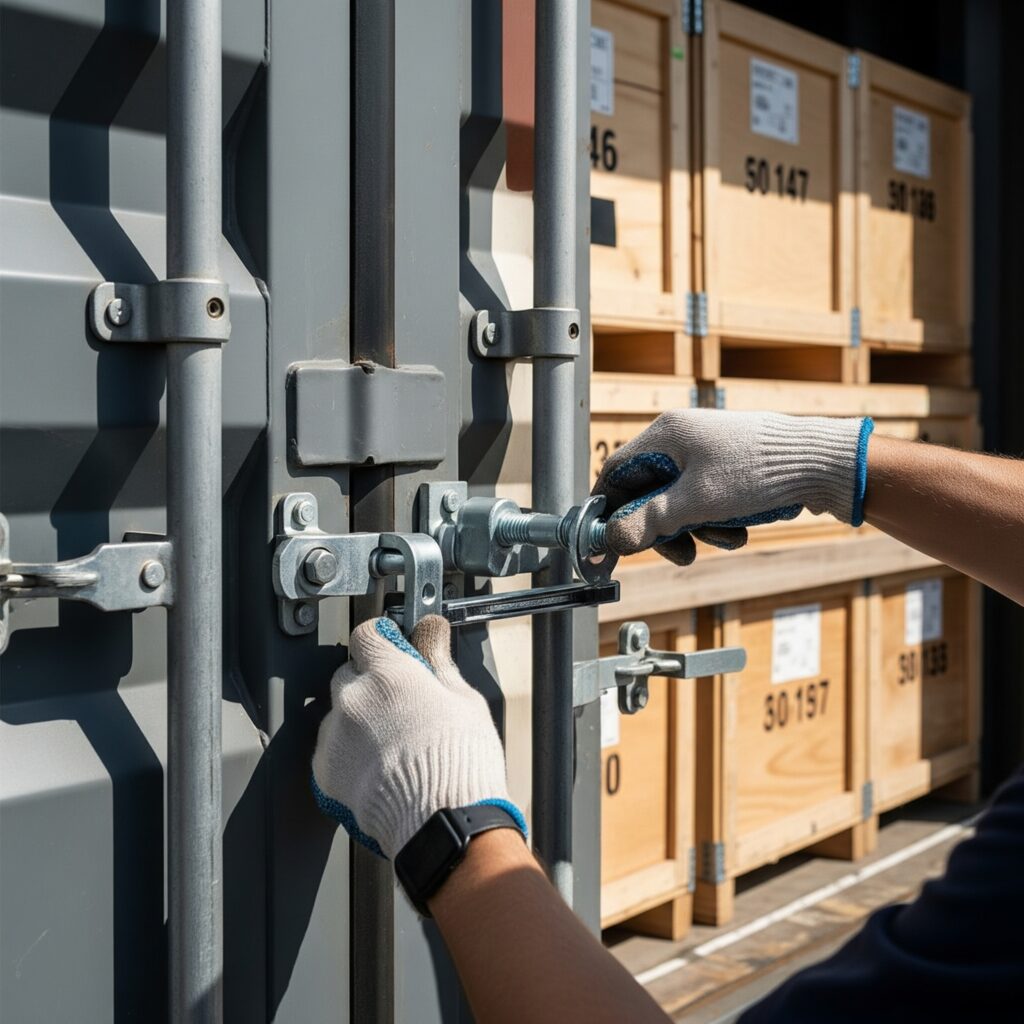
Part 3: The In-Transit & Delivery Phase
Once your container is properly loaded, sealed, and on its way, the focus shifts from physical preparation to information management and final-mile coordination. A top-tier logistics partner ensures this phase is as seamless and transparent as the first.
Step 6: Leveraging Technology for In-Transit Visibility
In the past, a shipment that had left the dock often entered a “black hole” of information until it was close to its destination. For a precise automotive supply chain, this is unacceptable. Modern technology provides the end-to-end visibility needed to maintain control and manage production effectively.
- Tracking Key Milestones: Your partner’s online portal should provide real-time updates on a series of critical events. You are no longer just tracking a truck; you are tracking key milestones in a managed process:
- Origin Ingate: Confirmation that the container has been safely checked into the origin rail terminal.
- Train Departure: Your container is on the train and moving. You will often see the train number and its scheduled path.
- Interchange Updates: For long-haul, cross-continental moves, you will see updates as the train passes through major rail interchanges (like Chicago, Memphis, or Kansas City).
- Destination Arrival: The train has arrived at the destination terminal, and your container is awaiting unloading.
- Available for Delivery: Your container is off the train and has been mounted on a chassis, ready for the final-mile drayage driver to retrieve it.
- Destination Outgate: The container has been picked up by the local truck and is now on its way to your assembly plant or facility for delivery.
- Integrating Data for Production Planning: This visibility is more than just peace of mind; it’s actionable data. A sophisticated plant manager can use the reliable Estimated Time of Arrival (ETA) from the rail network to schedule their receiving teams and dock doors with precision. This data can be fed directly into your internal production planning systems, allowing you to manage inbound inventory flow with a level of accuracy that is difficult to achieve with the variability of long-haul trucking.
Step 7: Coordinating the Final-Mile Delivery to the Assembly Line
The final delivery of your intermodal shipping container is a planned, coordinated event, designed to integrate smoothly with the high-tempo environment of an automotive plant.
- The Delivery Appointment: A key feature of this managed process is the delivery appointment. The destination drayage carrier will contact the receiving facility to schedule a specific date and time for arrival. This eliminates the chaos of multiple trucks showing up unannounced and creating a bottleneck in your yard. It allows your receiving team to prepare for the container’s arrival and unload it efficiently.
- “Drop and Hook” vs. “Live Unload”: Your logistics partner can help you determine the best delivery method for your facility.
- Live Unload: The driver waits while your team unloads the container, and then takes the empty container away. This is suitable for facilities with lower volume.
- Drop and Hook: For high-volume assembly plants, a “drop and hook” program is often ideal. The driver drops the full container in a designated spot in your yard and immediately hooks up to a pre-existing empty container to take back to the terminal. This is the most efficient method, as it keeps your dock doors free and minimizes driver time at your facility.
- Closing the Loop: Upon arrival, the receiver should verify that the container’s seal number matches the number on the Bill of Lading before breaking the seal. After unloading and inspecting the cargo, they will sign the Proof of Delivery (POD). This final signature confirms that the shipment was received in good order and officially closes the loop on a successful, end-to-end intermodal move.
Conclusion: Your Strategic Partner for a Resilient Future
Making the strategic transition to a multi-modal supply chain is one of the most powerful decisions you can make for the health and resilience of your automotive logistics network. The process, as outlined in these seven steps, is not a complex or daunting undertaking; it is a structured, professional pathway to achieving greater efficiency and control. From the initial, detailed preparation for a quote to the final, documented delivery at your facility, every stage is designed to build confidence and deliver predictable results.
By choosing to implement an intermodal shipping strategy, you are unlocking the proven benefits of lower costs, greater budget stability, enhanced cargo security, and a significantly reduced carbon footprint. More importantly, you are building a supply chain that is fundamentally more resilient and prepared for the challenges of the future. With the right expert partner guiding you, this transition becomes a seamless evolution of your logistics model.
The plan is clear. The benefits are proven. It’s time to put your data into action and see the results for yourself. Don’t let another day of volatile truck rates and capacity uncertainty pass. Partner with an expert and start building a more resilient and cost-effective automotive supply chain today.
Request Your No-Obligation Automotive Shipping Quote Now
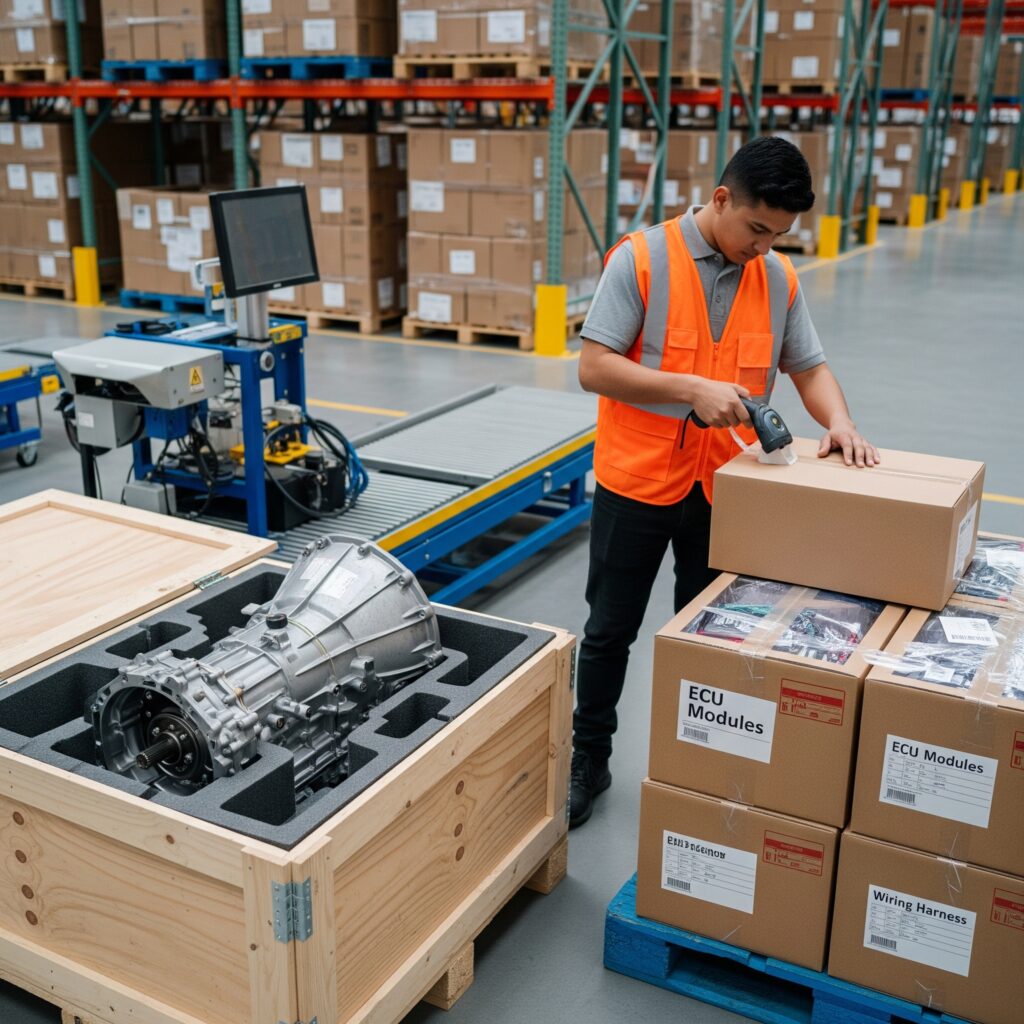
Additional Resources:
Intermodal Shipping with RailGateway
Automotive Intermodal Shipping
Canadian Vehicle Manufacturers’ Association (CVMA)
Automotive Parts Manufacturers’ Association (APMA Canada)
Automotive Logistics – Ultima Media
Government of Canada – The Canada-United States-Mexico Agreement (CUSMA)
